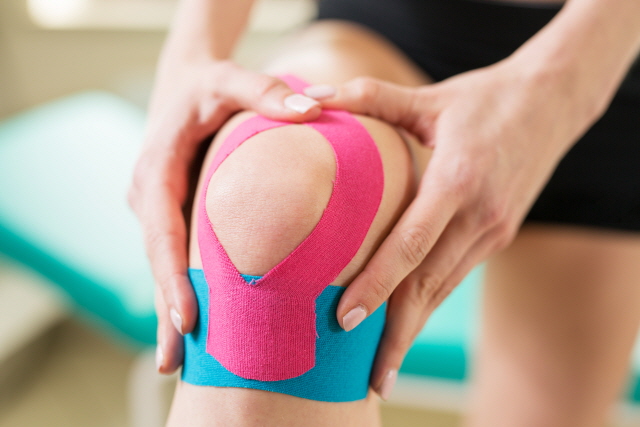
It requires professional knowledge of anatomy for the best result
By Winston Lee L. Ac, Ph.D., KMD
When I see patients with musculoskeletal disorders in my clinic, sports taping is a treatment I often use besides acupuncture. Also known as Kinesio Taping, Sports Taping, or KT tape, this is a tape that is attached to the patient’s skin for several hours or a day and then removed. This tape is not coated with drugs such as menthol, and its function is to semi-fix the injured area or support it with joint instability. In particular, it has a very special purpose and functions differently from general packing tape or paper because its elasticity is optimized to fit the skin and muscles of a patient.
When using this, it is necessary to distinguish which pain is coming from which cause. Suppose the problem is just caused by disc herniation or cartilage degeneration. In that case, this taping can be helpful, but you can’t see the direct effect. The indication for this taping is not pain from a relatively serious cause but excessive stretching of elastic fibers in muscles, tendons, and ligaments due to overusing in a short time or exercise outside the usual range of motion. Think about a round tee, for instance. It will be easier to understand how a Kinesio tape works. The rubber band around the neck is stretched too much and droops when the rubber band around the neck is severely pulled. What muscles, tendons, and ligaments have in common is elastic fibers like rubber bands, as mentioned above. Through this process, the area’s pain is improved quickly and buys time for self-healing. It also increases joint stability and reduces unnecessary frictional force, preventing inflammation from worsening.
It is important to completely understand the affected area’s anatomy for the best result. You need to know the muscle’s origins and insertions, their actions, their antagonist muscles, and their range of motion. It should be taped exactly according to this so that it does not come off easily and is effective. If you do taping only by looking at the picture without knowing the posture of attaching it without anatomical knowledge, there is little effect, and there are quite a few cases where the tape falls off easily or only shows skin irritations.
This method is characterized in that it does not cause pain through treatment like acupuncture, so not many patients are reluctant to this treatment. So, I make it a routine to do this taping after finishing acupuncture and cupping treatment. In addition, it is quite useful because it can be applied easily and conveniently even when playing outdoor activities or sports games and can show improvement immediately. In my personal experience, it showed almost immediate improvement when used for ankle sprains, tennis elbow, golf elbow, shoulder joint capsulitis, etc.
For example, this taping is very effective for pain caused by arthritis caused by abnormal friction in the knee joint where the back of the patella meets the tibia and femur, accompanied by instability of the patella in the knee. When a patient walks, the unstable patella moves up and down, left and right, causing unnecessary friction on the knee, which may lead to knee inflammation and cause pain. Suppose the patella is stabilized through the sports taping. In that case, the pain is immediately reduced thanks to the reduced friction, which can speed up self-healing. At the same time, taping that gives a little pressure on the knee can also quickly reduce swelling and pain.
As such, sports taping is very effective, but one of the biggest advantages is that there are almost no side effects. If I had to pick a side effect, it was an allergic reaction to an adhesive agent on the surface of a taping. In the case of some patients with sensitive skin, if taping is done for more than one or two days, the spot swells or itches. Therefore, the patient is instructed to apply this taping for one day and remove it the next morning. Allergic reactions like this show a considerable difference depending on the taping brand, so use various tapes for trial or listen to the reviews of doctors around you and choose a good one.
































